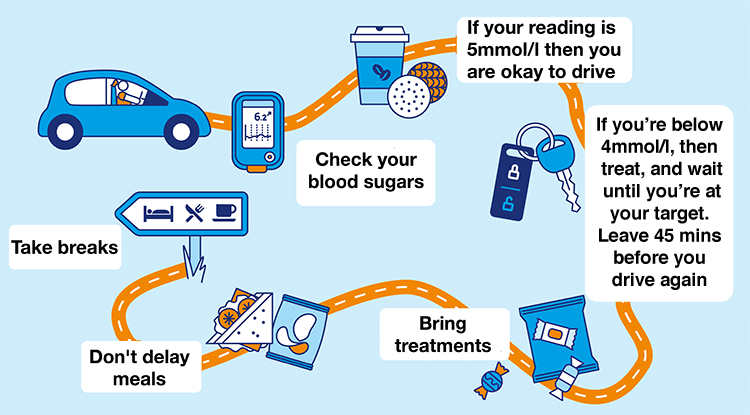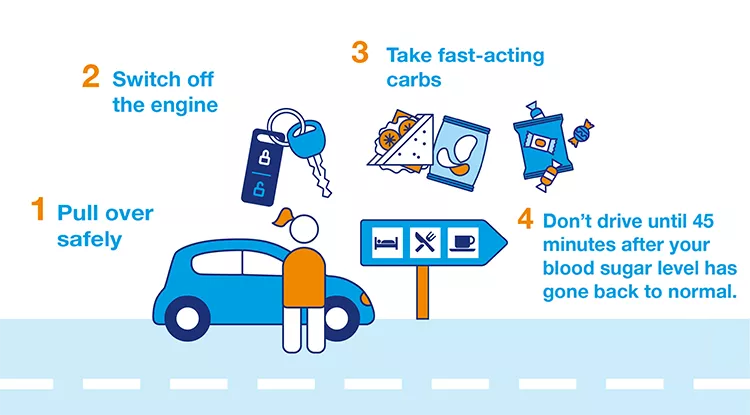For most people with diabetes, driving isn’t a problem, and you can hold a driving licence and carry on driving. Here you’ll find everything you need to know about diabetes and driving.
On this page:
- How diabetes can affect driving
- Driving and how you treat your diabetes
- Driving and eye complications
- Driving and hypo unawareness
- Other diabetes complications that can affect driving
- Your driving checklist if you’re at risk of hypos
- Diabetes and car insurance
- Driving for work when you have diabetes
- Can diabetes affect your driving licence?
How diabetes can affect driving
There are three main things about diabetes that can affect your ability to drive safely:
- If how you treat your diabetes means you’re at risk of having a hypo (where your blood glucose levels drop below 4mmol/l).
- Being unable to recognise the warning symptoms of hypos – known as hypo unawareness.
- If you develop diabetes complications that make it harder for you to drive – like problems with your eyes (retinopathy) or nerve damage (neuropathy).
If these things affect you, you need to know what the rules are and what you need to tell your local driver and licensing authority.
The rules are different depending on what vehicle you want to drive. Here we’ll talk mainly about what you need to know if you want to drive a car or motorbike (called a Group 1 licence).
To drive a lorry or larger vehicle, you’ll need a Group 2 licence. There are different rules for this type of licence and they can be more complicated when you are driving with diabetes.
{"preview_thumbnail":"/s3/files/styles/video_embed_wysiwyg_preview/public/video_thumbnails/bW_mZhg2j-k.jpg?itok=J5The1ZW","video_url":"https://www.youtube.com/watch?v=bW_mZhg2j-k&feature=youtu.be","settings":{"responsive":1,"width":"854","height":"480","autoplay":0},"settings_summary":["Embedded Video (Responsive)."]}
"As someone with diabetes, it's really important that I'm aware of the rules around driving in the UK" - Mim, who speaks about driving with diabetes in the video above.
These rules come from the Driver and Vehicle Licensing Agency (DVLA) in England, Scotland and Wales, and the Driver and Vehicle Agency (DVA) in Northern Ireland.
We use DVLA information throughout this guide, to make things simpler.
And remember, you need to know these rules if these things could affect you in the future if not now.
Driving and how you treat your diabetes
Can you still drive if you have diabetes? It depends if how you treat your diabetes means you're at risk of hypos, as this can affect your ability to drive safely.
So what makes you at risk of having hypos? Hypos can affect people who take certain medication to treat their diabetes, including insulin and medications like sulphonylureas.
Some hypos can be really severe where you need help to treat them. Speak to your healthcare team if you’re not sure whether you’re at risk of having these and what you can do to prevent them.
If you already know you're at risk of hypos, follow our checklist each and every time you drive.
However you treat your diabetes, use our table explaining the rules for your driving licence based on each type of treatment.

Driving and eye complications
Retinopathy is damage to the blood vessels supplying the eye’s retina (the seeing part at the back of the eye) and it can cause sight loss. It’s linked to high blood glucose levels and high blood pressure so it’s more common in people with diabetes.
If you start having problems with your eyes, you need to let the DVLA know and you may need a special diabetes eye test for driving. It’ll be done at an optician near you that’s recommended by the DVLA and they’ll pay for it.
Some eye problems can be treated successfully which means you can reapply for your licence. Ask your healthcare team if you’re not sure.
Driving and hypo unawareness
If you develop hypo unawareness – where you no longer have any warning signs of the onset of hypos (hypoglycaemia), you’ll need to let the DVLA know.
You will have to stop driving. This still applies if you are using continuous glucose monitoring (CGM) that alerts you with an alarm when your glucose levels are going low.
See the latest DVLA guidance on hypo unawareness on the GOV.UK website.
Other diabetes complications that can affect driving
Neuropathy affects your nerves. Damage to your nerves can mean you lose feeling in your hands and feet, as well as causing problems in various other parts of your body. If it’s severe then you should ask your healthcare team or the DVLA for more advice.
If neuropathy or an amputation mean you need an adapted vehicle, you’ll have to apply for an adapted vehicle licence from the DVLA. Diabetes complications shouldn't have to stop you driving.
Heart complications can affect your ability to drive and being able to hold a licence. Your specialist heart team must advise you here.
Other conditions the DVLA need to know about include things that could cause loss of consciousness or concentration, like sleep apnoea. This can make it harder for you to concentrate in the day due to extreme sleepiness. Talk to your healthcare team or sleep clinic about this.
They also need to know about any problems you develop that make it difficult to negotiate traffic or act quickly. For example a stroke, which is a cardiovascular complication, is when blood can't get to the brain and it's starved of vital oxygen and nutrients. This can happen if your blood vessels are damaged or blocked and can make it harder for you to react quickly.
We have lots of information to help you understand the DVLA diabetes rule and when to talk to the DVLA about your driving licence – we’ve created tables about Group 1 and Group 2 licences to help you find the information you need quickly and easily.
Your driving checklist if you’re at risk of hypos
Follow this diabetes driving hypo checklist each and every time you drive. It’s how you reduce your risk of a hypo at the wheel. And it’s how you can carry on driving safely.
- Know the symptoms of a hypo – if you’ve lost hypo awareness, you can’t drive.
- Keep spare test strips in the car and bring your meter with you - even if you use a CGM.
- Check your blood glucose levels before you set off and every two hours on long journeys.
- Five to drive – your blood glucose have to be 5mmol/l or above before you drive. If they’re between 4mmol/l and 5mmol/l, eat some carbs before heading out.
- If they’re under 4mmol/l – treat your hypo and check your levels again before driving.
- Always keep hypo treatments where you can easily reach them in the car.
- Take breaks on long journeys.
- Don’t delay meals or snacks.
Remember, the rules are more complicated around diabetes and truck driving or if you want to drive a large vehicle, with a Group 2 licence.
When to check blood glucose levels for driving
If you usually check your blood glucose levels, then you must follow the rules about when to check them. This means checking them just before driving however short the trip. On longer journeys, you must continue to check them at least every two hours, ensuring that no more than 2 hours has passed between checks at any time in your journey. Our Diabetes and your driving licence page provides guidance on who needs to check their blood sugar levels when driving. Always check the DVLA for the most up to date information for drivers with diabetes.
It's fine to use a CGM to check your glucose levels before you drive.
If you use a CGM to check your glucose levels when driving, DVLA rules say that this must be a device that’s approved for making treatment decisions like adjusting insulin or consuming carbs based on the CGM readings alone. This is called non-adjunctive use.
There are some CGMs which are available in the UK that need a finger-prick blood test to confirm readings before making treatment decisions. If you’re unsure if your CGM is approved for non-adjunctive use then you can ask your diabetes team if they’ve provided you with your tech, ask the manufacturer or contact our helpline.
These rules are only about checking for low blood glucose levels – the DVLA don’t have any specific limits on high blood glucose levels.
Speak to your healthcare team if you’re not sure whether you should be checking your glucose levels – it depends what medication you’re on.
If you start having a hypo while driving
It’s the law that you must stop. And it’s what you must do to avoid any risk of an accident. So find somewhere safe to pull in as soon as possible.

- Pull over safely. If you feel like your glucose levels are low then make sure you pull over as soon as possible.
- Switch off the engine. Take the keys out and move from the driver’s seat – if you don’t, the police can think you’re still in charge of the car and you could be prosecuted.
- Take fast-acting carbs, like glucose tablets or sweets, and some longer-acting carbohydrates too, like plain biscuits or crackers.
- Don’t drive until 45 minutes after your glucose levels have gone back to 5mmol/l or above. This is the time it takes for your concentration to go back to normal.
If you’re struggling with hypos, talk to your healthcare team about whether you should be driving.
You don’t need to let the DVLA know that you’ve had a hypo – only if it’s a severe hypo (where you need help to treat it). Severe hypos are a lot more serious so the rules are more detailed. We have more information about severe hypos if you don't know what they are.
Diabetes and car insurance
Most car insurance companies won’t charge more if you have diabetes. You should complain if they do and if you’re still not happy then try somewhere else.
You’ll have to declare your diabetes as a material fact when applying for insurance. We’ve information about insurance and diabetes to help you.
Driving for work when you have diabetes
If you drive as your job or use a car to get to work, you’re bound to worry about how changes to your driving licence could affect your job.
We have lots of advice and information on driving and work to help you understand what your rights are.
Can diabetes affect your driving licence?
If you have your licence revoked then you can nearly always reapply for it after some time. It depends why you lost your licence. The most common reason is because of severe hypos, which is where you need help and can’t treat it on your own.
You can apply for a new licence up to eight weeks before the date given on your refusal notice. What happens then will depend on why your licence was taken away. We have lots more information on what happens if you lose your licence.
More information and support on diabetes and driving
Our helpline has trained advisors who can help with specific problems or questions.
Our online forum is also a useful way to get tips and advice from others with diabetes.
